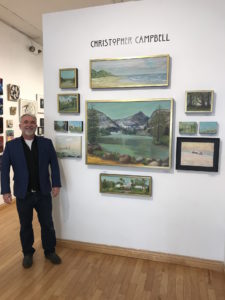
Christopher Campbell pulls weeds and paints willows.
An early member of San Francisco’s Recreation and Parks Natural Resources Division, Campbell, 55, has been familiar with Glen Canyon for 20 years, removing geriatric eucalyptus and colonizing Himalayan blackberry and replacing them with habitat-friendly dogwood, elderberry and sticky monkey flower.
And for the last six years, influenced by the neighborhood’s 60-acre natural area, he has brushed canvas and linen with his landscapes.
Some of his catalog is currently on display at City Art Cooperative Gallery at 828 Valencia Street, where it remains through January 27.
“I’m a plein air painter,” Campbell told the Glen Park News. “I begin painting in the field and often complete a work indoors.”
His palette has taken the upper state New York native throughout Sonoma, Marin and San Mateo counties where his work has graced canvases as small as 5”x7” and as large as 40”x60”.
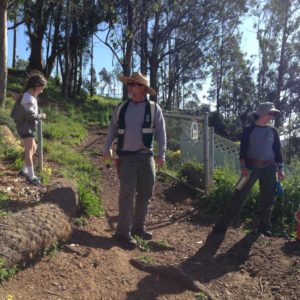
“I prefer long and narrow canvases such as 12”x 36”, said Campbell, who lives in Westwood Park and first visited San Francisco in 1986 and permanently moved here in 1993. “These help to convey the diversity of our landscapes and portray the environment where we live.”
Campbell was born in Granville, New York, on the Vermont/New York border. Granville is small, numbering around 6,000 inhabitants and has been called the “Colored Slate Capital of the World.”
“Quarries in the town mine slate that come in colors such as gray, black, mottled green, red and purple,” said Campbell, who earned a BA in geography and geology from SUNY in. “It’s very close to the home of painter Maxfield Parrish and near the summer vacation area of Georgia O’Keefe and photographer Alfred Stieglitz.”
Early years of rusticity, sequestered among New England fall colors, helped him develop an appreciation for nature and wildlife.
“The natural beauty of the land and the diversity of the landscape throughout the United States,” said Campbell, channeling an environmentalist passion he’s shared and fostered with his Natural Resources Division stewards. “I have always loved shadows and textures in nature and it is this appreciation that has helped me to capture a landscape.”
Glen Canyon is no stranger to panoramas, dotted as it is with grasslands and slopes, rife with red-tailed hawks and Great horned owls, and home to a seasonal creek that tongues through Arroyo willow. Campbell’s RPD canyon assignment boasts open meadows and Franciscan chert outcroppings, a pastiche of wildlife such as gophers, snakes, skunks, raccoons, even coyotes, not to mention sparrows and warblers.
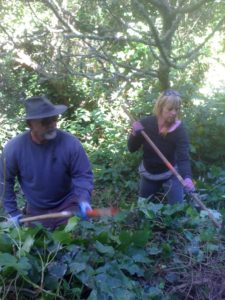
Campbell is not unappreciative of the synergy between his art and his day job, which calls for the management and maintenance of 31 San Francisco natural areas.
“My work with Rec and Parks’ NRD has been helpful,” said Campbell, who began his RPD career at Civic Center Complex, moved to Lang Field in the Western Addition and eventually to his own beat at Raymond Kimball Playground. “I understand scale and structural diversity, having worked with the land and developed a keen knowledge of it. I apply it to my paintings, although its taken me some time and much practice to do so.”
Campbell’s oeuvre boasts an airy ambience and envisions subjects in three sections, foreground, midground and background. He has been influenced by the California tonalist painters of the 1920s.
Self taught, he paints in oils.
“Claude Monet’s Tulip Fields was the first painting I fell in love with,” said Campbell, who also appreciates the work of Renoir.
While the Natural Resources Division began in 1998, City Art was not far behind, opening its gallery doors the same year, and remains, as Campbell says “a constant in the radically changing Valencia corridor.” Situated immediately next to Dave Eggers’ 826 Valencia, a non-profit dedicated to helping children and young adults develop writing skills, the idea for the 100-member gallery emerged when several friends who were also artists wanted to create a viable formula for a group-oriented business where they could regularly show their art and also open membership to other artists who may not have had other viable outlets.
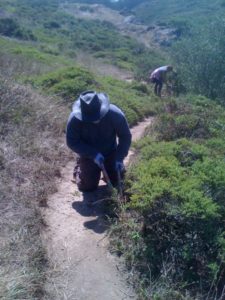
On a chilly day in January, Campbell circled the gallery, answering questions from patrons. Dressed in vintage clothing, rivaling apparel one might find in a Manhattan SoHo space, he directed a buyer to the sale counter.
Later he appraised his own collection, mounted in the center of the showroom.
“I display approximately twice a year,” he said. “Artists themselves sit shifts during the month they are showing and also cover other ongoing maintenance duties.”
His Glen Canyon duties — which witness him making waste of invasive radish, thistle, and mustard so that native wax myrtle, coffee berry, and coyote bush can flourish — see him in vastly different togs.
Suited up for NRD tasks, he more commonly dons a Carhartt hoodie from Acme Surplus Store on Mission Street than a vintage late twentieth century gabardine blazer from Schauplatz Clothing on Valencia Street.
Working with a lopper not a paintbrush, he makes no secret he prefers protection over tailoring while overseeing the Glen Park wilderness area.
“I generally wear heavy weight work clothes, favoring cotton or fleece,” he offered. “Long sleeve shirts, wide brimmed hats and sun screen also make do.”
Splitting sartorial hairs with weekend Levi’s and flannel plaid, Campbell, who takes the RPD title Chief Natural Resource Specialist, takes Days off recreating along familiar canyon trails. With his partner, Chris Conlisk, he sometimes walks the Islais Creek loop, trailing behind his two canines.
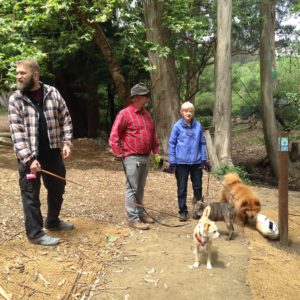
“On my days off I enjoy the park with our two small dogs, Bean, a French Bulldog and Henri, our rescue Jack Russell terrier mix,” he said. “The improved trails and stairs make it easy for the little pups to navigate the canyon.”
Twenty years ago, Christopher Campbell first wrestled with carpets of Cape ivy, working with California Native Plant Society volunteers Jake Sigg, Rich Craib, Greg Garr and Margo Boors.
“We removed poison hemlock from Islais Creek, just south of Silver Tree,” he said. “Interestingly, we are continuing to enhance wildlife habitat in this very area, removing weeds, some of the same ones we were removing 20 years ago.”
Twenty years on nature lovers who wish to engage the canyon’s riparian and hillside ecology can experience Campbell’s restoration efforts for themselves.
Once there they’ll see how continuing stewardship has made it possible for Glen Canyon’s biodiversity to continue for another generation.
If they can’t, well Glen Park residents need only hop Muni or BART, engage a bicycle share, or simply hoof it over to City Art on Valencia Street.
Once there they can determine for themselves if Christopher Campbell, with a dab or two of a paint brush, paid his respects to Glen Canyon with a jab or two of a mattock.